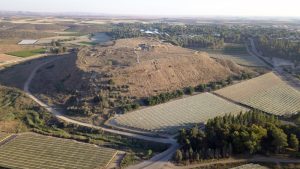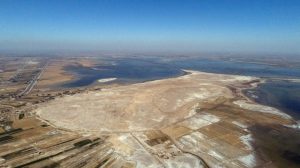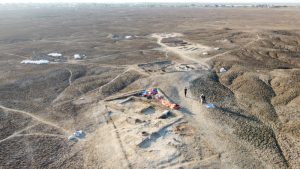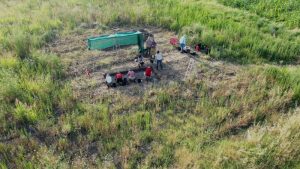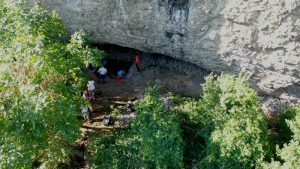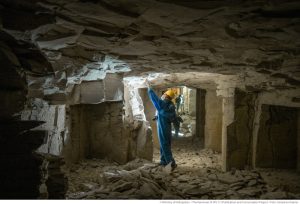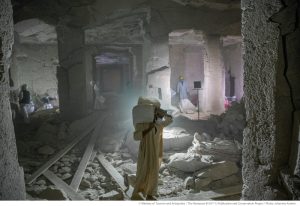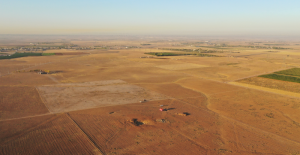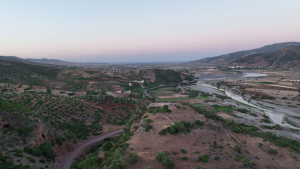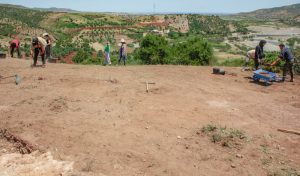
New ASOR-Affiliated Projects: February 2023
Currently, 115 projects are affiliated with ASOR. This includes 86 field projects and 29 publication projects. Fourteen projects (13 new projects and 1 project renewal) have received ASOR affiliation since last summer. Read more about these new ASOR-affiliated projects below!
ASOR-affiliated projects adhere to ASOR policies, most notably the Non-Discrimination Policy, Policy on Professional Conduct, and Code of Conduct for the ASOR Annual Meeting and Other ASOR Sponsored Events. These policies affirm ASOR’s commitment to high standards for research integrity, academic mentoring and ethical professional behavior. Project Principal Investigators may apply for ASOR affiliation for their projects through the Committee for Archaeological Research and Policy (CAP). Principal Investigators of ASOR-affiliated projects are eligible to apply for ASOR Project Grants and Shepard Urgent Action Grants. Students working on ASOR-affiliated projects are eligible to apply for Scholarships for Fieldwork Participation.
New ASOR-Affiliated Projects
Austrian Expedition to Tel Lachish, Israel (Felix Höflmayer and Katharina Streit)
The Austrian Expedition to Lachish focuses on the Middle and Late Bronze Age remains at the site. Since 2017, excavations have been conducted in Area S on the western edge of the site, uncovering several settlement phases of the early Late Bronze Age (15th and 14th century BC), and in Area P north of the Judean palace-fort, where additional parts of the Middle Bronze Age (17th and 16th century BC) palace were excavated.
Caesarea Coastal Archaeological Project (C-CAP), Caesarea Maritima, Israel (Asa Eger, Beverly Goodman, and Andrea de Giorgi)
The transition in the eastern Mediterranean from the Christian Late Roman Byzantine to Islamic rule beginning in the 7th century CE is a time full of uncertainty, migrations, conflict, and reconfiguring of people, economies, communities and cultures. While these changes are known in broad strokes due to historical records, archaeological information allows us to better understand the more direct meaning of these changes for those who lived at the time, as recognizable within the material record. In May-June 2022, the CCAP field school project invites students and volunteers to unravel the mysteries of Caesarea Maritima’s medieval and Islamic years, including both on land and underwater archaeological and geoarchaeological hands-on experience. Participants will immerse themselves in the world of the post-Roman Empire Islamic eastern Mediterranean, experience and reveal first-hand physical evidence of ancient natural disasters, and learn how to hear the stories from the objects that were left behind.
Kalavasos-Laroumena and Arkhangelos Archaeological Research Project, Cyprus (Mara T. Horowitz)
The Kalavasos-Laroumena and Arkhangelos Archaeological Research Project (K-LAARP) investigates social change in the Middle Cypriot Bronze Age on the south coast of Cyprus.
The Kurd Qaburstan Archaeological Project, Iraq (Tiffany Earley-Spadoni and Glenn Schwartz)
Kurd Qaburstan is an urban-sized Bronze Age site in northern Mesopotamia, southwest of Erbil in the Kurdistan Region of Iraq. Perhaps to be identified with ancient Qabra, the 118-hectare site consists of an 11-hectare central mound 17 meters high surrounded by a 107-hectare walled lower town. The project was initiated in 2013 by Dr. Glenn Schwartz, and is currently directed by Dr. Tiffany Earley-Spadoni.
Lagash Archaeological Project, Al Hiba, Iraq (Holly Pittman)
Excavations at ancient Lagash focus on understanding the urban organization during the Early Dynastic period. Remote sensing together with targeted excavation seeks to reveal craft production areas, domestic housing, and institutional installations.
Mudawwara Ottoman Fort, Jordan (Andrew Petersen)
Mudawwara fort is a ruinous Ottoman fort located on the Hajj route in southern Jordan. Although the fort was only built in the eighteenth century the site is mentioned in pilgrimage itineraries from at least the ninth century CE. The fort is currently in a very vulnerable state and the aim is to record the architectural remains and carry out excavations at the site in advance of conservation and restoration work.
Neanderthal Crossroads Project, Uzun Mera and Peshka, North Macedonia (Darko Stojanovski, Sarah Lacy, and Tracje Nacev)
The Neanderthal Crossroads Project is the first Middle Paleolithic field school in the Balkan region. Students will get the opportunity to learn surface survey and trench excavation techniques at a Middle Paleolithic archaeological site, Uzun Mera, as well as exploratory investigations at additional caves including Peshka Cave. The Middle Paleolithic history of the central Balkans is still not well-known, despite it being the clear crossroads for hominins into and out of Europe. North Macedonia is a gorgeous, NATO-member country in the central Balkans that is safe and relatively inexpensive. Please reach out with questions about our schedule, travel logistics, or CoVID protocols; we would love to have you join us this summer! We have a short video of last summer’s excavation here.
The Ramesses III (KV 11) Publication and Conservation Project, Egypt (Anke Weber)
The Project is dedicated to the excavation, conservation, and publication of the tomb of pharaoh Ramesses III (ca. 1221 – 1156 BC) in the UNESCO World Heritage Site of the Valley of the Kings. Between 1885 and 1914, the tomb was flooded several times, causing severe damage in its rear compartments, and making it inaccessible to visitors. Since 2017, The Ramesses III (KV 11) Publication and Conservation Project has worked continuously on the preservation and publishing of the site. The mud and rubble which had accumulated in the rear parts are gradually being cleared, in the course of which valuable information on the tomb’s decoration and even fragments of its former furnishings have come to light. Its unique architecture and decoration program make KV 11 an important source for Ramesside beliefs concerning the afterlife. The final aim is to prepare the tomb for reopening and making it fully accessible to the public at large. To document and protect the tomb from further decay, specialists from different countries work together in the fields of archaeology, conservation, geoarchaeology, microbiology, osteology, philology, photography, and Egyptological research. The project is hosted by Humboldt-Universität zu Berlin and led by Dr. Anke Weber.
Rural Landscapes of Iron Age Imperial Mesopotamia, Qach Rresh, Iraq (Petra Creamer)
Rural Landscapes of Iron Age Imperial Mesopotamia (RLIIM) is a combination excavation-remote sensing project conducted on the Erbil Plain of Iraqi Kurdistan, just 15km south of Erbil near the modern village of Tirpa Spiyan. Excavations focus on a small, rural agricultural settlement of the Assyrian Empire, Qach Rresh. The project uses drone imagery and magnetometry to map the subsurface and landscape features of the village and its surrounding landscape to understand how the occupants of these small villages interacted within the broader imperial framework. Additionally, post-Assyrian material at the site allows us to investigate questions related to the collapse of the Assyrian empire as seen from the countryside, as opposed to a large urban center. We conducted our first season in Fall 2022, and our permit issued by the KRG Department of Antiquities allows for another four years of investigation before renewal. The project’s team is a combination of Kurdish and foreign members, directed by Prof. Petra Creamer (Emory University). We prioritize the training of our team members in various archaeological techniques, emphasizing technology and remote sensing along with more traditional methods.
Tell Timai Project, Egypt (Jay Silverstein and Robert Littman)
Tell Timai is the Nile Delta city of Thmouis, a site famous for perfume production, its role in the Great Rebellion discussed on the Rosetta Stone, and its prominence in the rise of Christianity in Egypt. Excavations in the coming years will focus on a series of religious structures from the Late Period to the Coptic Periods. Information on 2023-2023 fieldwork can be found here.
Ulqin Archaeological Project:Landscape Survey and Geography, Southern Montenegro (Daniel Plekhov, Elic Weitzel, and Erina Baci)
The Ulqin Archaeological Project is a large-scale, diachronic regional survey of the Ulqin Municipality in southern Montenegro. Human occupation of this region dates to the earliest periods of human presence in Europe, with many subsequent cultures, states, and empires leaving their marks on the landscape through time. Our survey aims to document and study these traces. Through doing so, we will investigate how dynamics of human settlement and land-use in this region have changed through time and consider what effect they continue to have on the social and environmental characteristics of the region’s people and landscapes today. To that end, our project is focused as much on the archaeological remains of past periods as it is on the ongoing practices of local communities in the present. By combining archaeological methods with those from the fields of geography, ecology, and cultural anthropology, we will provide historical context for the development of modern-day settlement and agropastoral practices, and explore how communities today continue to inherit, adapt to, and transform the legacies of the past. Beyond studying the archaeological record of this region to understand its history and development, our project is also oriented towards the documentation and preservation of its rapidly disappearing heritage landscapes.
Unveiling the Farming-Herding Communities of II-I Millenium B.C. Mediterranean Western Maghreb, Kach Kouch, Morocco (Hamza Benattia)
The Western Mediterranean has been characterized by complex social and economic dynamics, with the movements of Late Bronze Age communities settling the African shores yet to be fully deciphered. The site of Kach Kouch (Oued Laou, Morocco), a settlement with no parallels in north-west Africa, offers a unique chance to understand these dynamics and their place within debates about the hyperconnectivity of the Mediterranean in the late 2nd and early 1st millennium BC. The strategic location of Kach Kouch, controlling the access from the estuary of the Oued Laou river to the inland valleys of the Western Rif mountains, makes it ideally placed within a wider exchange network connecting local communities with the rest of the Mediterranean. To date, the archaeology of this region has been written overwhelmingly from a colonial perspective, even though evidence points to early connectivity of this area since the 6th millennium BC. This project focuses on the study of Kach Kouch and its territory, including the bassins of Oued Laou and Stehat, from a long durée perspective and with an emphasis on the role of local communities in the historical process. This project serves as a field school for young graduates and undergraduates in archaeology of the National Institute of Archaeology and Heritage of Morocco (INSAP).
Vasagard, Denmark(Finn Ole Nielsen, M. Nicolas Caretta, Michael Thorsen, Ditte Kofod, and Roxana Youkhana)
The site of Vasagård is located on the southern side of the island of Bornholm, Denmark. Vasagård is separated by the 100m Læså valley from two nearly identical Neolithic sites and consists of a tomb system where a dolmen and a passage grave can be found close to the settlement. The grave system and causewayed enclosures are dated from c. 3500 BC, and constitute the most north-eastern occurrence of this complex type in Europe. During the excavations of 2013-2017, almost three hundred broken and completely flat, engraved stones were uncovered, marked with patterns of radiating straight lines. Named “sunstones” or “solar stones”, archaeologists from the Bornholm Museum have postulated that these artifacts were likely part of the rituals carried out by Neolithic sun-worshipping practitioners about 5,000 years ago. New excavations will help to increase and improve the information about the site and the Neolithic Period in the Baltic region.
ASOR-Affiliated Project Renewals
Carthage, The Precinct of Tanit (tophet) and Ba’al: The ASOR Punic Project: The Stager Excavations (1975-1979), Tunisia (J. A. Greene, B. K. Garnand, and L. E. Stager†)
This publication will present the results of the archaeological excavations at the so-called tophet or “Precinct of Tanit” in Carthage, Tunisia. These excavations were undertaken as part of the ASOR Punic Project (1975–1979) with funding from the Smithsonian Institution, the University of Chicago and Harvard University under auspices the UNESCO Campagne de Sauvegarde Carthage. The first volume will present a complete descriptive catalogue of artifacts, the second volume a detailed interpretation of stratigraphy, osteology and typology (urns, amulets, cippi/stelae), alongside interpretations of classical and biblical literary sources and epigraphic evidence, in order to present for the first time a holistic interpretation of Phoenician/Punic votive dedication of infants. This singular site has provided the vast majority of the Phoenician/Punic iconographic and epigraphic repertoire known from ca. 800–146 BCE.
†=deceased
American Society of Overseas Research
The James F. Strange Center
209 Commerce Street
Alexandria, VA 22314
E-mail: info@asor.org
© 2023 ASOR
All rights reserved.
Images licensed under a Creative Commons Attribution-NonCommercial-ShareAlike 4.0 International License
COVID-19 Update: Please consider making payments or gifts on our secure Online Portal. Please e-mail info@asor.org if you have questions or need help.
